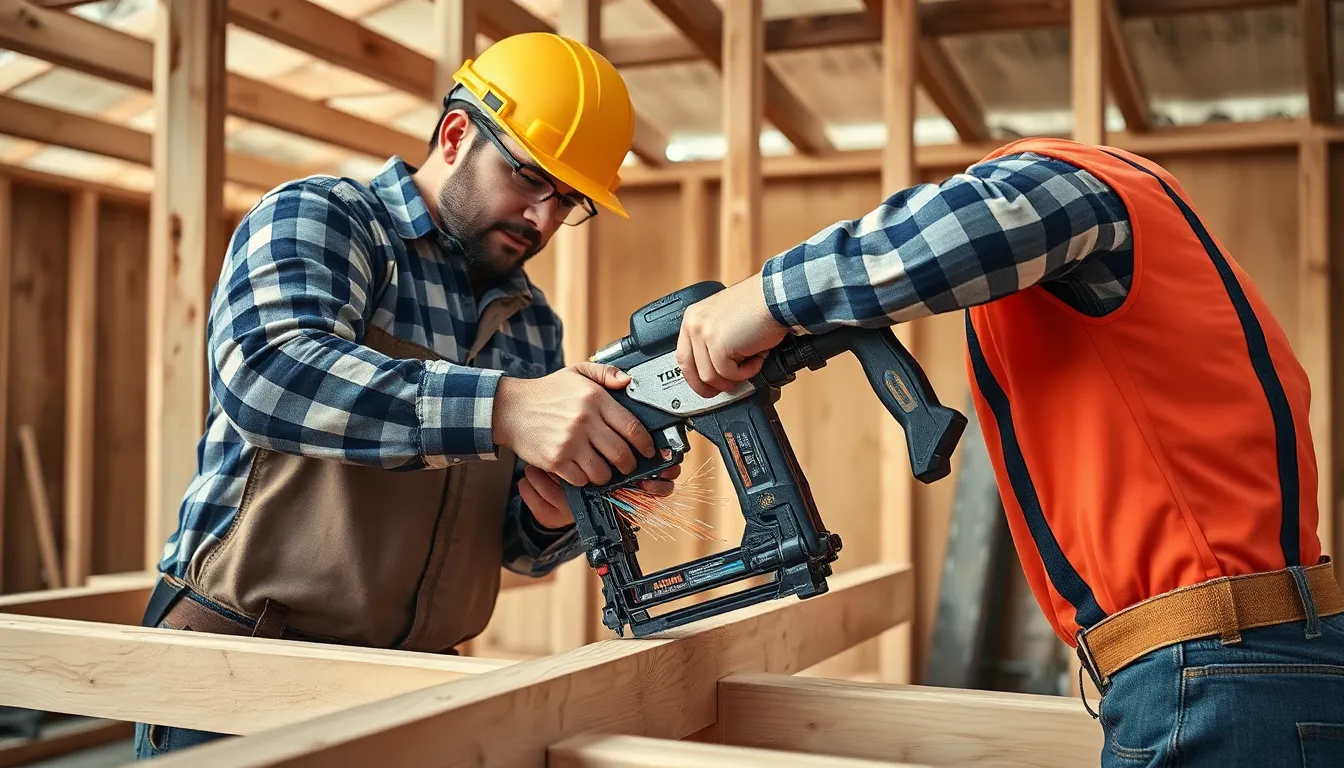Nail guns have revolutionized the construction and woodworking industries, offering speed and efficiency that traditional hand tools simply can’t match. These powerful devices drive nails into various materials with precision, making them indispensable for both professionals and DIY enthusiasts alike. As projects become more complex and time-sensitive, understanding the ins and outs of nail guns has never been more crucial.
Whether it’s framing a house or crafting intricate furniture, the right nail gun can make all the difference. With various types available—each suited for specific tasks—choosing the right one can be overwhelming. This article will explore the different types of nail guns, their features, and tips for selecting the best tool for any job, empowering users to tackle their projects with confidence.
Table of Contents
ToggleOverview of Nail Guns
Nail guns play a crucial role in modern construction and woodworking, significantly enhancing speed and efficiency in fastening materials. Understanding their functionality and types is essential for achieving optimal results in various projects.
What Is a Nail Gun?
A nail gun, also known as a nailer, is a power tool designed to drive nails into various materials using compressed air, electricity, or chemicals. Nail guns automate the nailing process, significantly reducing manual effort and time. They can drive nails at high speeds, making them suitable for both professional and DIY applications.
Types of Nail Guns
- Pneumatic Nail Guns:
- Use compressed air to drive nails
- Require an air compressor
- Common in heavy-duty construction
- Electric Nail Guns:
- Use electric power for nail driving
- Available in corded and cordless versions
- Offer portability, particularly the cordless models
- Gas-Powered Nail Guns:
- Utilize a gas canister to generate pressure
- Ideal for areas without electricity
- Deliver power equivalent to pneumatic models
- Staple Guns:
- Designed specifically for staples instead of nails
- Useful for upholstery, crafts, and light construction
- Available in manual, pneumatic, and electric forms
- Finish Nailers:
- Drive smaller, finishing nails
- Suitable for trim work and cabinetry
- Provide a cleaner look with minimal visible nail heads
- Brad Nailers:
- Use brad nails, which are even smaller than finish nails
- Ideal for delicate projects like picture framing
- Create less damage to the material being fastened
Benefits of Using Nail Guns

Nail guns offer significant advantages in construction and woodworking projects. Their automation leads to faster completion times and enhanced overall performance.
Increased Speed and Efficiency
Nail guns perform tasks faster than manual methods. A pneumatic nail gun can drive up to 700 nails per hour, compared to the average human, who may only insert 30 nails in the same period with a hammer. This efficiency results in quicker project turnaround, allowing professionals to handle larger workloads. The ability to reload quickly and operate with minimal downtime increases productivity on job sites.
Improved Precision
Nail guns deliver enhanced accuracy in fastening materials. The tools reduce the risk of misaligned nails, ensuring consistent depth and placement. Many models feature adjustable settings to accommodate different materials and specific nail lengths. This precision minimizes damage to workpieces, reducing the need for costly repairs or rework. Using nail guns leads to cleaner finishes, particularly in detailed projects where aesthetics matter.
Safety Considerations
Using nail guns poses certain hazards that require attention. Proper safety measures can prevent injuries and ensure a safer working environment.
Common Hazards
- Injury Risks: Nail guns can cause severe injuries, including puncture wounds, fractures, or lacerations. Misfires or improper handling increase these risks significantly.
- Repetitive Strain: Continuous use can lead to musculoskeletal injuries, particularly in the hands, wrists, and arms. Frequent breaks and stretching exercises can mitigate this issue.
- Flying Debris: Nails that miss their target may ricochet or become airborne, posing threats to nearby workers. Awareness of surroundings is critical to avoid these incidents.
- Electrical Hazards: Electric nail guns may expose users to electrical shocks if used improperly or in wet conditions. Always follow manufacturer instructions and maintain equipment in good condition.
Essential Safety Gear
- Safety Glasses: Protect eyes from flying debris and nail misfires by wearing safety goggles or glasses with side shields.
- Hearing Protection: Use earplugs or earmuffs to shield against harmful noise levels, especially when using pneumatic tools.
- Hard Hats: Hard hats safeguard against falling objects and provide additional head protection on construction sites.
- Gloves: Wear tough, padded gloves for hand protection while maintaining dexterity in handling tools.
- Steel-Toed Boots: Ensure feet are protected from heavy equipment or falling materials by wearing steel-toed footwear.
Popular Nail Gun Brands
Numerous brands offer reliable nail guns, each with unique features catering to various needs in construction and woodworking. Here are two notable brands recognized for their quality and performance.
Brand A Overview
Brand A stands out for its extensive range of pneumatic nail guns. Designed for both professionals and DIY enthusiasts, its models feature lightweight bodies and ergonomic handles, enhancing user comfort during prolonged use. The brand incorporates advanced safety mechanisms, preventing accidental discharges. With driving speeds reaching 600 nails per hour, these nail guns increase productivity on job sites. Additionally, Brand A offers adjustable depth settings, allowing users to customize nail placement for different materials and applications.
Brand B Overview
Brand B specializes in electric nail guns known for their versatility and ease of use. Offering corded and cordless models, it caters to varying preferences in power sources. Its nail guns feature a powerful motor, driving nails efficiently into hard materials like hardwoods. Users appreciate the quick-release jam clearing feature, which minimizes downtime during projects. Brand B also emphasizes safety with a sequential trigger mechanism, reducing the likelihood of accidental firing. With a commitment to innovative design, these nail guns are suitable for a wide range of tasks, from framing to finishing.
Choosing the Right Nail Gun
Selecting the appropriate nail gun significantly impacts project outcomes. Consider the following factors and recommended models to enhance efficiency and effectiveness.
Factors to Consider
- Type of Projects: Identify whether the project involves framing, finishing, or light-duty tasks. Different nail guns serve specific purposes, such as framing nailers for heavy-duty applications and brad nailers for delicate trim work.
- Power Source: Evaluate the options: pneumatic, electric, or gas-powered. Pneumatic nail guns require a compressor, offering consistent power but limited portability. Electric models provide convenience and ease of use, while gas-powered guns combine mobility with robust power.
- Nail Size Compatibility: Acknowledge the nail sizes the gun can accommodate. Nail lengths commonly range from 1 inch to 3.5 inches, affecting the tool’s versatility for different materials.
- Weight and Ergonomics: Assess the weight and design. A lighter tool reduces fatigue during prolonged use, while ergonomic handles provide better grip and control, enhancing comfort and precision.
- Safety Features: Look for features like dry-fire lockout and adjustable depth settings. These enhance safety and allow for better control of nail placement, reducing the risk of mishaps.
- Budget: Determine a comfortable price range. Nail gun prices vary significantly based on type and brand, so consider long-term value in investment.
Recommended Models
| Model | Type | Power Source | Nail Size Range | Notable Features |
|---|---|---|---|---|
| Brand A Framing Nail Gun | Pneumatic | Compressed air | 2 to 3.5 inches | Lightweight, powerful, and durable |
| Brand B Cordless Electric Nailer | Electric | Battery | 1 to 2.5 inches | Quick-release jam clearing, adjustable settings |
| Brand C Gas-Powered Finish Nailer | Gas-powered | Gas cartridge | 1.25 to 2.5 inches | High mobility, excellent for outdoor use |
| Brand D Brad Nailer | Electric | Corded | 0.75 to 2 inches | Compact design, perfect for trim work |
| Brand E Staple Gun | Electric | Corded | 0.75 to 1.25 inches | Great for upholstery and light-duty projects |
Select from these models based on specific project needs, ensuring optimal performance and safety.
Nail guns have revolutionized the construction and woodworking industries by enhancing speed and precision. Their ability to drive nails quickly and accurately makes them invaluable tools for both professionals and DIY enthusiasts. With various types available, users can choose the right nail gun to suit their specific needs and projects.
Safety remains a crucial aspect of using nail guns. Proper precautions and safety gear can significantly reduce the risk of injuries. By understanding the features and benefits of different nail guns, users can make informed decisions that lead to successful outcomes in their projects. Embracing these powerful tools not only boosts productivity but also elevates the quality of work in any construction or woodworking endeavor.




